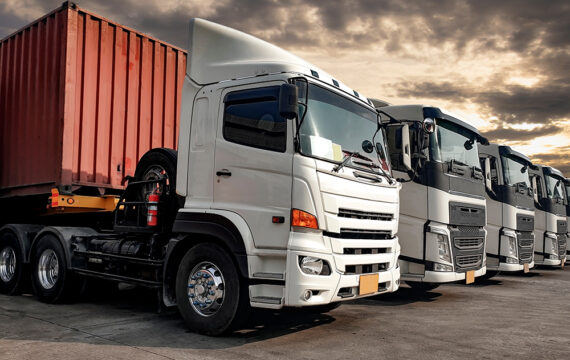When your business depends on moving assets, you can’t easily see the big picture. Fleet management and trucking businesses fall into this category.
Put simply, movement always brings risks. Road accidents, cargo damage, false claims, vehicle repairs, and drivers’ health are the most critical risks — and the most costly. On average, 20% of vehicles in a trucking company’s fleet will be involved in an accident in a given year.
Average cost of a fleet accident

Source: Verizon Connect — How Smart Video Fuels Smart Business
Improving safety and performance is a critical task for fleets and trucking businesses. Technology plays an important role in mitigating driving-related risks. Video telematics paired with GPS tracking play the biggest role.
Let’s look at how cameras can track fleets to ensure they’re safe and performing at their best.
What you’ll find in this article:
- Definitions of terms including video telematics and fleet dash cam solutions
- Challenges that video based telematics can solve for fleets
- How to make fleet camera systems work using advanced software
- Benefits of video telematics illustrated with real use cases
Video telematics, fleet dash cam solutions, and other terms
Telematics stands for telecommunications and informatics. The term refers to extensive data flows that come from various sources like connected IoT sensors, fleet dash cam solutions, and continuous video streams. Telematics assists in establishing relevant and permanent pipelines for collecting business-critical data on vehicles, drivers, and fleet operations.
Video telematics refers to the flow of video data. Images or video streams come to a fleet management system where computer vision technology and machine learning algorithms can recognize deviations from normal conditions. Paired with GPS location tracking and data on vehicle conditions, video telematics offers a complete picture of vehicles and drivers throughout their routes.

Collected video telematics data can carry clues for improving fuel consumption, driving behavior, vehicle routes, fleet efficiency, and safety on the road. It’s obvious why today more than 22% of fleet vehicles use video-based telematics to gather valuable insights for business improvements.
Main components of video telematics

Fleet owners should consider the following technologies for efficient fleet tracking with cameras:
- HD quality recording and streaming
- Wide line of sight for a full view of road events
- Automated alerts based on video recognition
- Integration with mobile devices for rapid updates
- Continuous recording of video to a single storage location
- Automated analytics to notify of relevant footage
- Video classification backed by AI and machine learning
- Easy remote access to video via any device
- Simultaneous analytics of video and other vehicle data
Fleet dash cam solutions with video telematics give businesses a clear view of events that occur during transportation. Monitoring and recording of the road ensures a better understanding of the causes of accidents. Video telematics provides important context to reveal risky driving behavior like hard braking or overtaking other vehicles.
Challenges that video based telematics can solve for fleets
Running a fleet and trucking business is hard and requires an investment of time and other resources. Implementing video based telematics and fleet dash cam solutions can help fleet and transportation companies protect their businesses. There are many challenges video telematics can solve to make trucking efficient and profitable.
Goals fleets want to achieve by implementing camera-based tracking
- Understand causes of driver fatigue
- Avoid distractions on the road
- Encourage safe driving
- Reduce driver turnover
- Secure cargo from damage
- Prevent severe collisions
- Increase fleet performance
- Save money on false insurance claims
- Optimize expenses on vehicle maintenance
How to make fleet camera systems work using advanced software
Let’s assume you’ve already installed cameras throughout a vehicle. They ensure basic advanced driver assistance system (ADAS) functionality for safe and fast responses to road events. You’ve also equipped the vehicle with inside cameras to actively monitor driver fatigue. Your fleet consists of vehicles that look like this:
A vehicle with basic sensors, cameras, and other safety equipment

Equipping vehicles with all the hardware is half of the job for efficient fleet tracking with cameras. What happens backstage relies on fleet software systems deployed in the cloud (MS Azure, AWS, or Google Cloud) for easy access and scalability.
Another critical part of the puzzle is integration with GPS and spatial data to match a vehicle’s camera data with the location where each event takes place. Pairing video telematics with GPS data increases the accuracy of monitoring speeding, crossing of geofences, and drivers’ decisions at the wheel.
Powered by AI-based analytics and automated decisions, video telematics systems can assist in classifying road events and draw attention to potentially dangerous factors during the ride. In addition, driver behavior analytics empower fleet companies to build relevant driver training programs based on facts and field data instead of assumptions.
Benefits of video telematics with real use cases
Driver scoring and evidence
A provider of ADAS platforms for the mining industry who collected telemetry data from various sources to complement their own fleet dash cam solutions needed to eliminate negative driving behavior with real video evidence for their customers. To do this, they needed to implement automated analytics powered by AI to classify driver behaviors and integrate GPS data for precisely locating events. All data insights needed to be easily available through their platform and integrated with a driver training module that’s accessible via mobile devices.
Benefits the ADAS provider got from video telematics:
- Video telemetry module records video and uses AI algorithms to recognize inappropriate driving behavior
- Driving mistakes and hazards that appear on the road are interpreted and transferred to a training module for drivers that need special safety courses
- Drivers are scored and receive bonuses for safe driving
- GPS modules match potentially dangerous events with locations to build optimal and safe routes and recognize parties involved in accidents
- Video evidence is stored for further analysis of insurance claims
Operational efficiency of fleets
A distribution company applied fleet camera systems to analyze the situation after collisions and save millions on legal fees. The company also wanted to reduce maintenance costs by training drivers on how to avoid potentially hazardous situations and how to act if they are happening. Apart from obtaining a better understanding of accidents, the distributor increased its operational efficiency.
Benefits the distribution company received from video telematics:
- Optimized fuel management with reporting on consumption, routes, and spending
- Decreased costs on vehicle maintenance thanks to relevant prediction of repairs
- Increased safety of vehicles and cargoes thanks to real-time tracking of road situations and driver behavior
- Increased customer satisfaction due to visibility of delivery routes and assurance of cargo safety
Measurable safety metrics
A food delivery company used video telematics to improve safety by applying clear metrics based on video evidence. Improvements to the company’s safety profile in the eyes of insurance providers cut costs per claim by 40%. The company also achieved a 12% decrease in near-collision events and a 24% increase in seat belt use by drivers.
Benefits of video telematics for food delivery:
- Reduced rate of collisions
- Cost savings on insurance plans and claims
- Increased driver safety
- Less aggressive driving behavior on the road
Compliance with regulations and customer requirements
A transportation company implemented fleet tracking with cameras to comply with industry safety program and reach new customers who demand a proven safety record. This fleet tracking system helped the company increase their CSA sore — a key indicator of the safety and quality of their delivery services — by 42%.
Benefits of video telematics for transportation:
- Fulfill ELD mandate
- Prove company policies for seat belt use and speed limits
- Ensure vehicles use authorized roads for deliveries based on geofences
- Transparently track collision rates to showcase cargo integrity
These cases are inspiring, aren’t they?
If you’re ready to develop a video telematics solution or already have all the equipment but need assistance with software engineering, be sure to contact Intellias.
Our experts have a track record of successful projects related to fleet tracking software and telematics data. We’ll help you get the most out of telematics, wireless connectivity, and GPS data to improve the performance, safety, and profitability of your fleet and trucking business.





